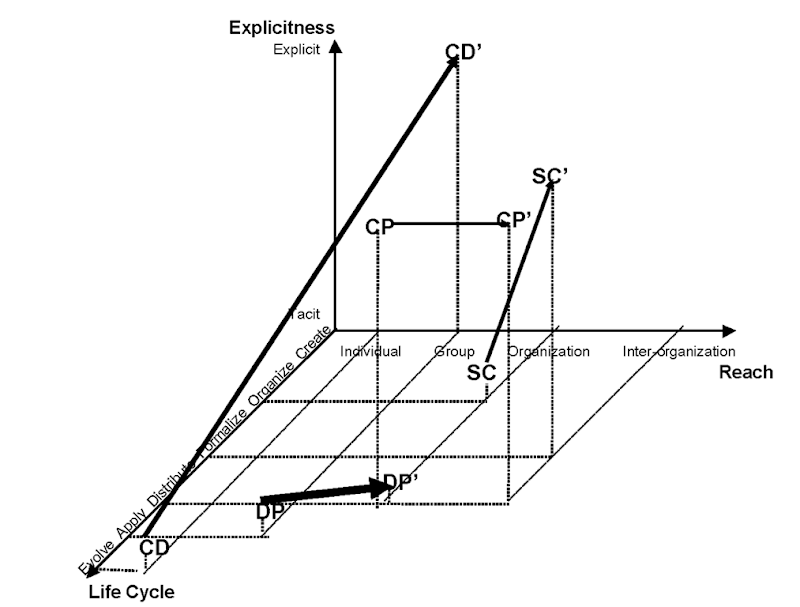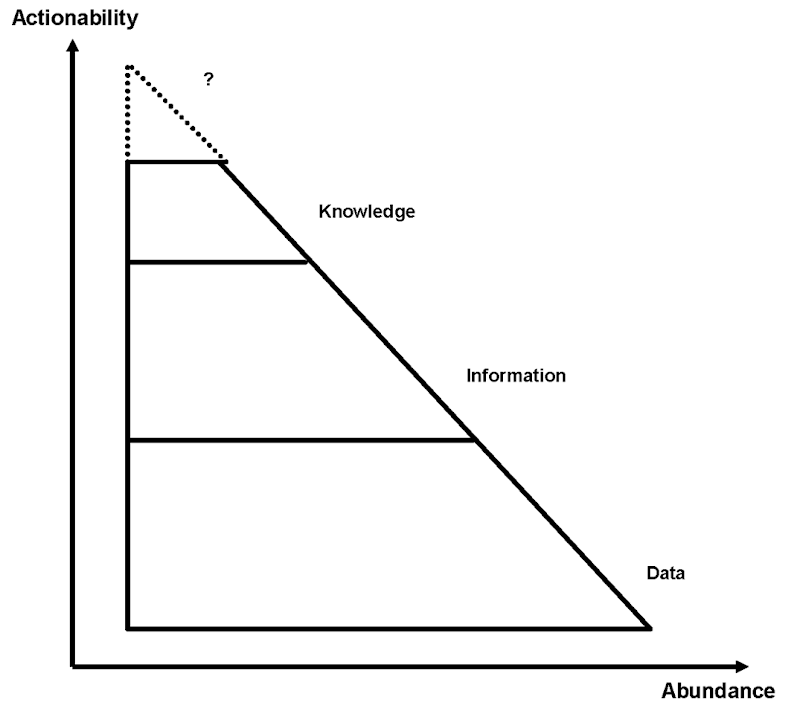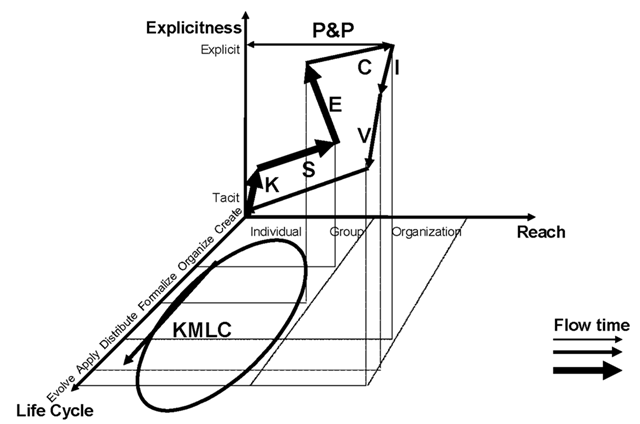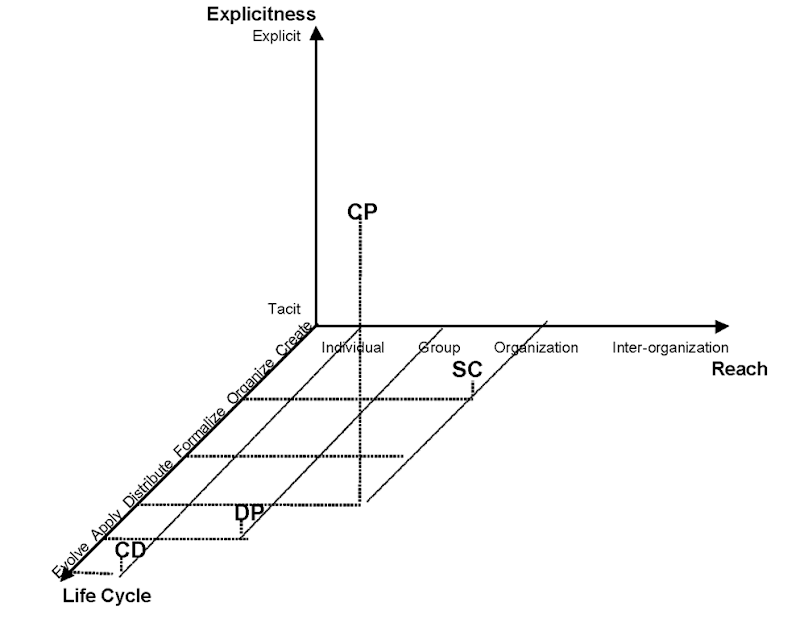INTRODUCTION
The practice of knowledge management (KM) purports to take the power of knowledge to the group, organization and even enterprise level (Davenport & Prusak, 1998). Although this potential benefit of KM is not viewed universally (Gore & Gore, 1999; McDermott, 1999), many scholars (e.g., Drucker, 1995) assert that knowledge represents one of the very few sustainable sources of competitive advantage. Hence, the knowledge-based organization—one that competes on the basis of its differential knowledge (e.g., see Grant, 1996, for discussion of the knowledge-based view of the firm)—appears to offer great promise in terms of performance and capability.
Drawing from Nissen (2004), the knowledge-based organization must be able to apply substantial knowledge, when and where it’s needed, to affect organizational goals. However, knowledge is not distributed evenly through the organization, so rapid and efficient knowledge flow is critical to enterprise performance. The larger, more geographically dispersed, and time-critical an enterprise (e.g., global manufacturing firms, telecommunication and software companies, military forces), the more important knowledge flow becomes in terms of efficacy. Unfortunately, our collective knowledge of how knowledge flows is quite primitive (Alavi & Leidner, 2001; Nissen, 2002). Lacking knowledge-flow theory and application for guidance, even enterprises with multimillion-dollar KM projects have difficulty seeing past information technologies such as intranets and Web portals. Further, Nissen, Kamel, and Sengupta (2000) note such KM projects rely principally upon trial and error, one of the least effective approaches known.
BACKGROUND
This section draws heavily from Nissen (2004) to summarize key background pertaining to knowledge flow. It focuses in particular on important concepts from the emerging literature on knowledge management and augments current work on knowledge flows (e.g., Baumard, 2002; Echeveria-Carroll, 1999; Fang, Lin, Hsiao, Huang, & Fang, 2002; Foss & Pedersen, 2002; Gupta & Govindarajan,2000; Schulz & Jobe, 2001; Zhuge, 2002). For the purposes of this article, three important concepts from the KM literature are summarized: 1) knowledge hierarchy, 2) knowledge management life cycle, and 3) current knowledge-flow theory.
Knowledge Hierarchy
Many scholars (e.g., Davenport & Prusak, 1998; Nissen et al., 2000; von Krogh, Ichijo, & Nonaka, 2000) conceptualize a hierarchy of knowledge, information, and data. As illustrated in Figure 1, each level of the hierarchy builds on the one below. For example, data are required to produce information, but information involves more than just data (e.g., need to have the data in context). Similarly, information is required to produce knowledge, but knowledge involves more thanjust information (e.g., it enables action). We operationalize the triangular shape of this hierarchy using two dimensions—abundance and action-ability—to differentiate among the three constructs.
Briefly, data lie at the bottom level, with information in the middle and knowledge at the top. The broad base of the triangle reflects the abundance of data, with exponentially less information available than data, and even fewer chunks of knowledge in any particular domain. Thus, the width of the triangle at each level reflects decreasing abundance in the progress from data to knowledge. The height of the triangle at each level reflects actionability (i.e., the ability to take appropriate action, such as a good decision or effective behavior). Converse to their abundance, data are not particularly powerful for supporting action, and information is more powerful than data. But knowledge supports action directly, hence its position near the top of the triangle. Curiously, there is current speculation as to one or more additional levels “above” knowledge in such hierarchies (e.g., wisdom; cf. Spiegler, 2000). The present article does not attempt to address “wisdom flow.”
Knowledge Management Life Cycle
Nissen et al. (2000) observe a sense of process flow or a life cycle associated with knowledge management. Integrating their survey of the literature (e.g., Davenport & Prusak, 1998; Despres & Chauvel, 1999; Gartner Group, 1999; Nissen, 1999), they synthesize an amalgamated KM life cycle model as outlined at the bottom of Table 1.
Figure 1. Knowledge hierarchy (adapted from Nissen, 2002)
Table 1. Knowledge management life cycle models (Adaptedfrom Nissen et al., 2000)
| Model | Phase 1 | Phase 2 | Phase 3 | Phase 4 | Phase 5 | Phase 6 |
| Despres and Chauvel | Create | Map/ bundle | Store | Share/ transfer | Reuse | Evolve |
| Gartner Group | Create | Organize | Capture | Access | Use | |
| Davenport & Prusak | Generate | Codify | Transfer | |||
| Nissen | Capture | Organize | Formalize | Distribute | Apply | |
| Amalgamated | Create | Organize | Formalize | Distribute | Apply | Evolve |
Briefly, the creation phase begins the life cycle, as new knowledge is generated within an enterprise; similar terms from other models include capture and acquire. The second phase pertains to the organization, mapping, or bundling of knowledge, often employing systems such as taxonomies, ontologies, and repositories. Phase 3 addresses mechanisms for making knowledge formal or explicit; similar terms from other models include store and codify. The fourth phase concerns the ability to share or distribute knowledge in the enterprise; this also includes terms such as transfer and access. Knowledge use and application for problem solving or decision making in the organization constitutes Phase 5, and a sixth phase is included to cover knowledge refinement and evolution, which reflects organizational learning—and thus a return to knowledge creation—through time. It is important to note, as in the familiar life cycle models used in IS design (e.g., System Development Life Cycle), progression through the various phases of this Life Cycle Model is generally iterative and involves feedback loops between stages; that is, all steps need not be taken in order, and the flow through this life cycle is not necessarily unidirectional.
Current Knowledge-Flow Theory
This section summarizes the dynamic model developed by Nissen (2002). It begins by building upon Nonaka’s (1994) work to conceptualize an extended model of knowledge-flow dynamics. This extended model is intended to help managers to understand better how enhancing knowledge flow can increase enterprise intelligence. The first step is to augment Nonaka’s two-dimensional framework by incorporating a third dimension, the KM life cycle. We operationalize the construct using the life cycle stages from the Amalgamated Model presented in Table 1.
The second step requires relabeling the epistemological and ontological dimensions. Because the terms episte-mological and ontological can be confusing when used in the present context, we relabel them as explicitness and reach, respectively, to target directly the principal focus of each dimension (i.e., differentiating explicit vs. tacit knowledge; indicating how broadly knowledge reaches through an enterprise).
In Figure 2, we note a few notional vectors for illustrating and classifying various dynamic patterns of knowledge as it flows through the enterprise. For example, the simple linear flow labeled “P&P” (i.e., Policies & Procedures) depicts the manner in which most enterprises inform, train, and attempt to acculturate employees: explicit documents and guidelines that individuals in the organization are expected to memorize, refer to, and observe. As another example, the cyclical flow of knowledge labeled “KMLC” (i.e., KM life cycle) reflects a more complex dynamic than its simple linear counterpart. This flow describes a cycle of knowledge creation, distribution, and evolution within a workgroup, for example.
Further, Nonaka’s dynamic model of knowledge flow can also be described in this space by the curvilinear vector sequence corresponding to the processes labeled “SECI” (i.e., socialize, externalize, combine, internalize), “externalize”, “combine”, and “internalize”. Thus, our model subsumes the one proposed by Nonaka and shows a complex dynamic as knowledge flows along the life cycle. Moreover, examination of this space suggests also including (and connecting) the “create” and “refine” vectors, which are not part of Nonaka’s theory but represent key elements of the empirically derived Life Cycle Model (e.g., the key to knowledge generation and evolution). Clearly, a great many other flows and patterns can be shown in this manner.
APPLICATION EXAMPLE – NEW PRODUCT DEVELOPMENT
Drawing concepts from Nissen (2004) in this section, we know the business environment now changes very rapidly, and the frequency of such changes is only expected to increase through time. Business processes must change even more rapidly for the knowledge-based organization to anticipate—not simply react to—new competitive requirements and market opportunities. Hence, the days of fixed business rules (e.g., embedded in static workflow or ERP systems) are long gone, as enterprises must be able to reconfigure processes quickly to capitalize on often-ephemeral advantages. To accomplish such agile reconfigurability, enterprise knowledge must flow quickly and efficiently across space, time and organizational units as process changes dictate. Again, enterprise knowledge flow is critical to performance.
To help ground in practice our knowledge-flow model previously described, we illustrate its application through an example of new product development in 21st century.
Figure 2. Notional knowledge-flow vectors
Figure 3. Current enterprise knowledge
Figure 4. Required knowledge flows

We can similarly ground the knowledge-flow model in other application domains (e.g., banking, consulting, manufacturing, telecommunications)—in which some of the specifics vary, but the principles hold constant. However, this example should convey clearly the key ideas. Typically heavy investments in plant and equipment for new product development confine most physical capital to specific geographical locations, and processes based upon such plant and equipment are very resistant to short-term changes. Yet global customer markets and supplier bases demand just such short-term changes. This represents a challenging context in terms of knowledge flow. Further, increasingly global markets and operations cause the demand for specific products to be unpredictable and to shift continually. New product design cycles can barely keep up with such demand shifts, and dynamic supplier networks change with each new product offering.
Here we discuss four areas of knowledge that appear to be critical: 1) customer demands, 2) competitor products, 3) design processes, and 4) supplier capabilities. In Figure 3, we use our multidimensional model to depict and examine such critical knowledge. Beginning with customer demands, the three-dimensional plot point corresponding to such knowledge is labeled “CD” in the figure. Notice it is plotted at the tacit end of the explicitness axis (e.g., future customer wants are generally not explicitly stated), the individual level in terms of the reach dimension (e.g., customer preferences are developed by individuals), and evolve stage of the life cycle (i.e., customer tastes evolve through time).
Even with this single step of classifying and plotting customer-demand knowledge in terms of our multidimensional model, we have identified a critical knowledge element, and can compare and contrast it visually with other key elements of knowledge. In similar fashion, knowledge of competitor products (i.e., labeled “CP” in the figure), internal design processes (i.e., labeled “DP”) and supplier capabilities (i.e., labeled “SC”) are also plotted in this figure. This set of points provides us with a view of the firm’s critical knowledge as it exists today. We explain below how such knowledge is not flowing to where (and when) a knowledge-based organization needs it to be, even though it is deemed critical. This motivates the need for inducing knowledge flow.
In Figure 4, we plot these same four points along with their counterparts depicting how knowledge in each area needs to flow in terms of our three model dimensions. For instance, customer-demands knowledge needs to be made explicit, and its reach must extend at least to the level of a marketing group within the firm. The question of where along the life cycle depends upon how agile and proactive the firm wishes to be; as depicted in the figure (i.e., point CD’), ideally the firm would want to create customer demand through new-product innovation and brand loyalty. A vector connecting the current and desired knowledge points (i.e., CD-CD’) is shown to delineate the corresponding knowledge flow requirement. Here we understand now what knowledge is critical, the state of such knowledge, and how it must flow to enable new product innovation.
Points and vectors corresponding to necessary knowledge flows in terms of competitor products (i.e., CP-CP’), supplier capabilities (i.e., SC-SC’), and design processes (i.e., DP-DP’) are classified, identified, and plotted in similar fashion in Figure 4. For instance, unlike (tacit)customer demands, knowledge of competitor products is already explicit and distributed, but the requisite knowledge flow shows such knowledge must also be made explicit across organizations (i.e., within our firm as well as the competitors’); this requires business intelligence to identify what competitors are doing in relevant marketspaces.
The knowledge flow corresponding to supplier capabilities is similar (e.g., required to flow beyond the supplier and into our firm), except such capabilities (e.g., in terms of new product development) must also be made explicit (i.e., not left as unarticulated potential) through formaliza-tion; this requires competitive sourcing to identify and help develop promising suppliers. Finally, design-process knowledge is required to flow beyond a specific design group, which suggests organization-wide distribution, however, distributing tacit knowledge as such remains a difficult undertaking, as it is often referred to as “sticky” in the product-development context (Szulanski, 1996; von Hippel, 1994).
FUTURE TRENDS
What kinds of future trends are suggested by inducing knowledge flows in the analysis described previously? For one, this particular analysis provides insight into the reality that one size does not fit all in terms of KM and IT. Rather, the key lies in focus on how the requisite knowledge associated with each vector can be induced to flow in situations where it is currently “clumped” or “constricted” (e.g., the marketing flow described previously). For another, to induce knowledge flows, the extant tools and processes employed by most successful firms can be integrated and targeted to focus specifically on the corresponding knowledge. Using knowledge-flow induction as outlined previously, the manager can ask what is preventing this specific knowledge from flowing today, and reconfigure the enterprise’s tools and processes to obviate the problem.
The analysis described previously also points to future trends in terms of new IT. For instance, we now know better than to focus IT on information and data, and such knowledge can be used to focus research and development specifically upon classes of technologies that can address knowledge directly. Some such technologies such as those of data mining and artificial intelligence are known relatively well, whereas others such as “knowledge amplifiers” and “knowledge engines” have yet to be invented. Finally, inducing knowledge flows as described previously has implications in terms of research. Despite the progress reflected in this article, our level of ignorance pertaining to knowledge-flow dynamics remains high. Nonetheless, having a multidimensional model and representational method to depict knowledge flows can help guide such research.
CONCLUSION
The knowledge-based organization appears to offer great promise in terms of performance and capability. This article summarizes the current state of the art pertaining to knowledge flow, and provides an overview of a model to help induce the flow of knowledge through an organization. Using a global manufacturing firm as an example to illustrate how the knowledge-flow model provides practical guidance, we identify knowledge elements that are critical to effective performance in an unpredictable, dynamic business environment, and we use the multidimensional model to illustrate how to identify specific knowledge flows required for success. This enables managers to analyze the knowledge flows of their organizations, and provides insights both in terms of future trends and directions for research and development.
KEY TERMS
Competitive Advantage: Employing organizational resources in an advantageous manner that cannot be imitated readily by competitors.
Extended Model of Knowledge-flow Dynamics: A four-dimensional model used to classify and visualize flows of knowledge in the organization.
Knowledge-based Organization: An organization that competes on the basis of its differential knowledge.
Knowledge Flow: The movement or propagation of knowledge across space, time, people and organizations.
Knowledge Hierarchy: The hierarchical relationship between knowledge, information and data, with each level building upon the one below.
Knowledge Management: Capitalizing on intellectual assets in the organization.
Knowledge Management Life Cycle: The cycle of activities associated with managing knowledge.



